I’ve wanted to leave the realms of fantasy behind this time, and move on into the vastness of open space, but then this came up:
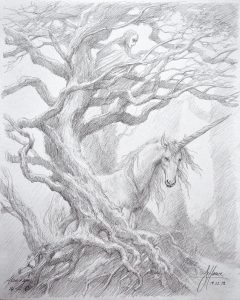
— so I decided to write a blog post on unicorns, instead of exploding spaceships. Which proved quite rewarding, in terms of the variety and quality of images I found.
The first mentions of the unicorn, Wikipedia tells us, are found in Greek natural history treatises. Ctesias, a Greek physician of the 5th century B.C., sees no reason to doubt their existence. They live in India, and look like “wild asses, fleet of foot, having a horn a cubit and a half in length and colored white, red and black.” That happens to be a colour scheme which recurs in fairy tale: “White as snow, red as blood, black as ebony wood.”

Four hundred years later, Pliny the Elder still locates the unicorn in India, and gives another description: “a very fierce animal called the monoceros which has the head of the stag, the feet of the elephant, and the tail of the boar, while the rest of the body is like that of the horse; it makes a deep lowing noise, and has a single black horn, which projects from the middle of its forehead, two cubits in length.”
The re’em, an animal which is described in the bible – wild, untameable, and used as a symbol for strength – has been variously translated as “unicorn”, although it more likely refers to a wild bovine. Medieval tradition draws both on those biblical mentions, and the descriptions handed down from antiquity. The animal is variously depicted with the traits of a wild ass, goat, or horse, but it is always gracile, and fairly small in size.

The well-known myth that the fierce and shy animal could only be tamed by a pure virgin, in whose lap it would fall asleep, orginated in a treatise known as Physiologus, written in Alexandria probably in the 2nd century A.D.

This myth gave rise to an elaborate allegory which interpreted the unicorn as Christ, and his falling asleep in the virgin’s lap, as the Incarnation – the virgin thus stood for the Virgin Mary. These days, we would tend to give it a rather more Freudian interpretation!
Probably the best-known medieval depiction is the late Gothic series of tapestries known as The Hunt of the Unicorn, which is now housed in the Cloisters in New York. This visual interpretation strongly influenced the depiction of this mythical animal even to the present day – it also firmly sets his colour to white, which was not previously the case.


These days, the unicorn is most often depicted as a white horse with a narwal-type horn in the middle of its brow. Sometimes it grows a pair of swan wings as well, which seems rather like a conflation with the winged horse Pegasus, of Greek myth and poetic inspiration.





Peter S. Beagle’s novel “The Last Unicorn“, and the animated movie based on it, certainly helped to re-ignite contemporary interest in the unicorn. The story also introduced the concept that the unicorn is, in fact, female. Most illustrations for the novel, and the movie art, emphasize grace and fragility, and they re-introduce unhorselike characteristics, such as cloven hooves, a tail that is more like a cow’s or antelope’s, and sometimes, a goat’s beard.



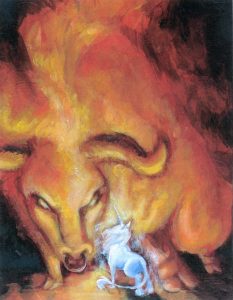
The shape of the unicorn is ever in flux. How disappointed must Marco Polo have been when he, expecting a small fierce creature which would gracefully put its head in a virgin’s lap, instead encountered a real rhinoceros! “[They are] scarcely smaller than elephants. They have the hair of a buffalo and feet like an elephant’s. They have a single large black horn in the middle of the forehead… They have a head like a wild boar’s… They spend their time by preference wallowing in mud and slime. They are very ugly brutes to look at. They are not at all such as we describe them when we relate that they let themselves be captured by virgins, but clean contrary to our notions.”
These artists have been experimenting with grafting the unicorn on to various animal shapes:


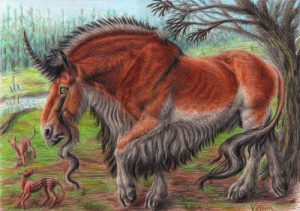

And the colour black is back: A range of dark unicorns, from an eerie looking thestral crossover, to a winged tattoo design – and even a cuttlefish inspired zebra unicorn statue!



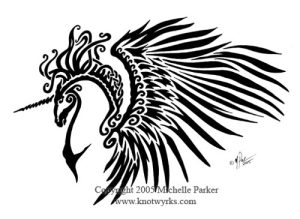

For some reason, I could not find a depiction of the Invisible Pink Unicorn. However, you might want to watch out that you don’t find this in your frozen lasagna! In any case, here is a classification table of various unicorn types, arranged by size:

Further in the scientific approach, here are the life stages of a female unicorn:

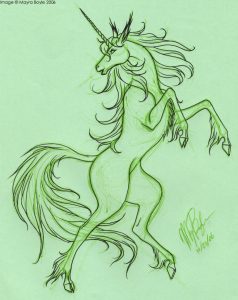

Last but by no means least – and bringing this post elegantly round back to its beginning – here is a set of unicorn sketches by John Howe. I’m not sure if they are officially called anything but “unicorn”, or if they are published somewhere or done for a specific purpose, but privately, I’ve dubbed them “The Taming of the Unicorn”: her expression seems to go from spooked and shy, to wary, to more trusting, and being perhaps a bit curious and intrigued.



John Howe and Alan Lee fans among you, and collectors, don’t forget to check out that auction! And see you in a fortnight, in space.
Astrid Nielsch











To anyone interested in bidding on the John Howe/Alan Lee sketch: it appears that this morning, Ebay shut the whole charity auction down, apparently because they were suspicious of the increased activity on that seller account! Gee-zez. Here is more info: https://robinsullins.com
Hopefully Ebay will restore the auction soon, I'll keep an eye on it and post here when it is reactivated. I noticed there were a couple of bids after this blog went up, so if you read this …
I should point out that I am in no way affiliated with the people running the auction, the sketch came to my attention and I thought it was a pretty unique piece of art, and an opportunity which might be of interest to some of the people reading this site. Any questions, please feel free to comment here or contact me!
UPDATE: The auction has now been relisted, but any previous bids have been lost, so it's starting again from scratch and if you've bid previously, you'll need to BID AGAIN. I've updated the link on the image to the current auction, it's also here: https://www.ebay.com/itm/Alan-Lee-John-Howe-COLLAB…
On the upside, it will now be listed until 4 March.
What a pain.